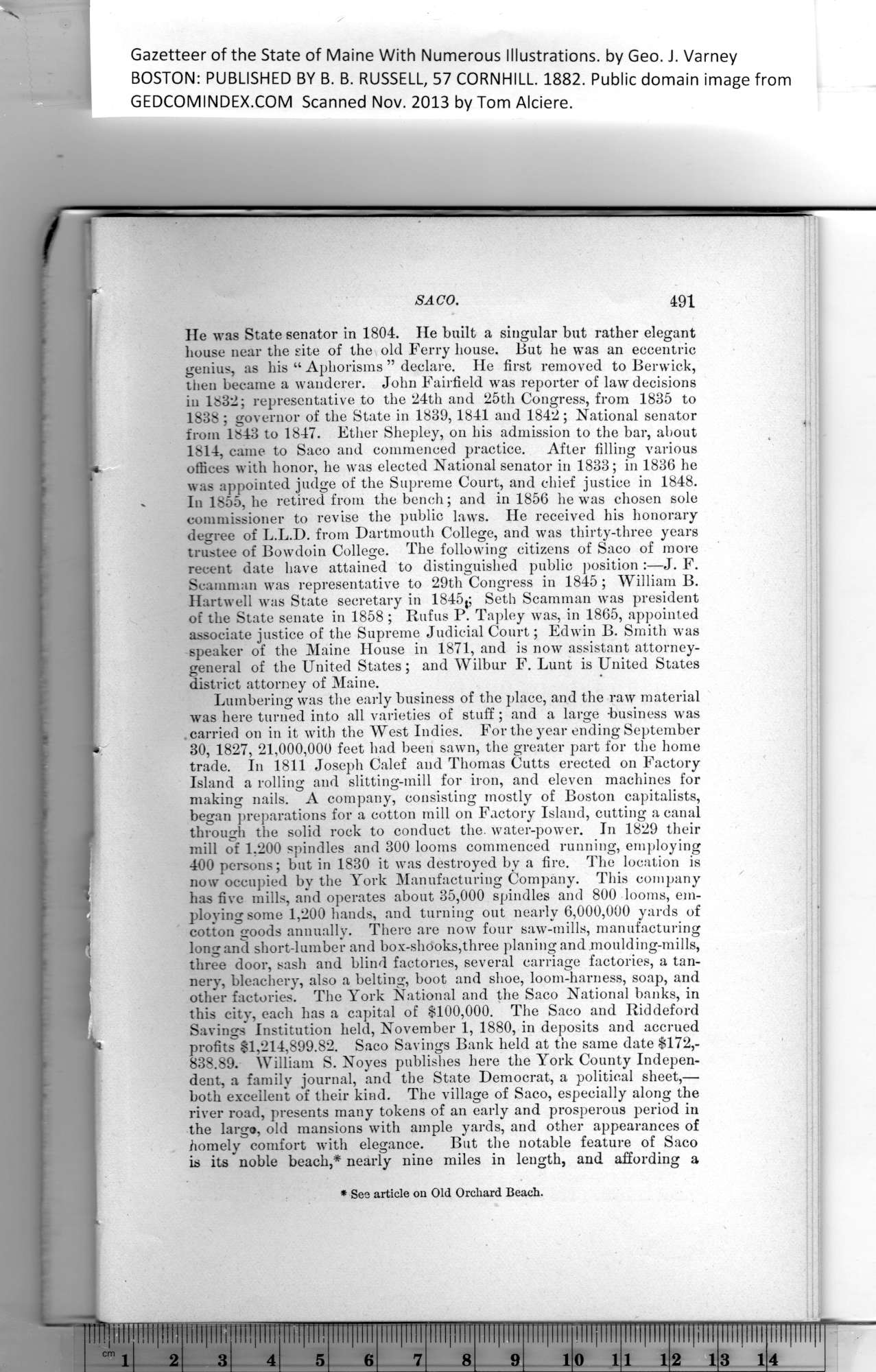|
Gazetteer of the State of Maine With Numerous Illustrations, by Geo. J. Varney
BOSTON: PUBLISHED BY B. B. RUSSELL, 57 CORNHILL. 1882. Public domain image from
SACO. 491
He was State senator in 1804. He built a singular but rather elegant
house near the site of the old Ferry house. But he was an eccentric
genius, as his “ Aphorisms ” declare. He first removed to Berwick,
then became a wanderer. John Fairfield was reporter of law decisions
in 1832; representative to the 24th and 25th Congress, from 1835 to
1838 ; governor of the State in 1839, 1841 and 1842; National senator
from 1S43 to 1847. Ether Shepley, on his admission to the bar, ahout
1814, came to Saco and commenced practice. After filling various
offices with honor, he was elected National senator in 1833; in 1836 he
was appointed judge of the Supreme Court, and chief justice in 1848.
In 1855, he retired from the bench; and in 1856 he was chosen sole
commissioner to revise the public laws. He received his honorary
degree of L.L.D. from Dartmouth College, and was thirty-three years
trustee of Bowdoin College. The following citizens of Saco of more
recent date have attained to distinguished public position :—J. F.
Scamman was representative to 29th Congress in 1845 ; William B.
Hartwell was State secretary in 1845{; Seth Scamman was president
of the State senate in 1858 ; Rufus P. Tapley was, in 1865, appointed
associate justice of the Supreme Judicial Court; Edwin B. Smith was
speaker of the Maine House in 1871, and is now assistant attorney-
general of the United States; and Wilbur F. Lunt is United States
district attorney of Maine.
Lumbering was the early business of the place, and the raw material
was here turned into all varieties of stuff; and a large -business was
carried on in it with the West Indies. For the year ending September
30, 1827, 21,000,000 feet had been sawn, the greater part for the home
trade. In 1811 Joseph Calef and Thomas Cutts erected on Factory
Island a rolling and slitting-mill for iron, and eleven machines for
making nails. A company, consisting mostly of Boston capitalists,
began preparations for a cotton mill on Factory Island, cutting a canal
through the solid rock to conduct the. water-power. In 1829 their
mill of 1,200 spindles and 300 looms commenced running, employing
400 persons; but in 1830 it was destroyed by a fire. The location is
now occupied by the York Manufacturing Company. This company
has five mills, and operates about 35,000 spindles and 800 looms, em-
ploying some 1,200 hands, and turning out nearly 6,000,000 yards of
cotton goods annually. There are now four saw-mills, manufacturing
long and short-lumber and box-shooks,three planing and moulding-mills,
three door, sash and blind factories, several carriage factories, a tan-
nery, bleachery, also a belting, boot and shoe, loom-harness, soap, and
other factories. The York National and the Saco National banks, in
this city, each has a capital of $100,000. The Saco and Rid deford
Savings’ Institution held, November 1, 1880, in deposits and accrued
profits $1,214,899.82. Saco Savings Bank held at the same date $172,-
838.89. William S. Noyes publishes here the York County Indepen-
dent, a familv journal, and the State Democrat, a political sheet,—
both excellent of their kind. The village of Saco, especially along the
river road, presents many tokens of an early and prosperous period in
the largo, old mansions with ample yards, and other appearances of
homely comfort with elegance. But the notable feature of Saco
is its ” noble beach,1 nearly nine miles in length, and affording a
1
Sea article on Old Orchard Beach.
PREVIOUS PAGE ... NEXT PAGE
This page was written in HTML using a program written in Python 3.2
|
